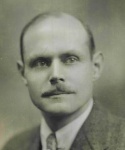Henry Chadwick Award: Fred Lieb
This article was written by Daniel R. Levitt
This article was published in Fall 2013 Baseball Research Journal

FRED LIEB (1888–1980) started writing for Baseball Magazine in 1909 and was still contributing to The Baseball Research Journal 67 years later. In between he was one of baseball’s top New York sportswriters and a key correspondent for The Sporting News. At mid-century Lieb packaged his extensive knowledge into a half-dozen team histories, invaluable to anyone researching the game behind the scenes over the first half of the twentieth century.
Lieb grew up in South Philadelphia with a love of both baseball and writing, and one year his parents gave him a small printing press for Christmas. He took a job as a clerk in the railroad office of Norfolk & Western, working at writing on the side. He contributed several player biographies to Baseball Magazine and wrote a couple of baseball short stories. Lieb’s first player interview was with Eddie Collins, who at the end convinced Lieb to give up his straight razor for a new safety razor. He moved to Clarence Barron’s Philadelphia News Bureau to advance his writing career, but when he saw an opening for a baseball writer at the New York Press he jumped at it.
With the Press Lieb joined what many consider the golden age of New York sportswriting, and Lieb became friends with many of America’s most famous sportswriters, including Damon Runyon, Heywood Broun, Grantland Rice, and Sid Mercer. Because the Press writer was also the official scorer for the Giants games, Lieb assumed that duty too as a 23-year-old rookie sportswriter. Over the next couple of decades Lieb covered baseball in New York for several papers and was president of the BBWAA from 1921 to 1924. Lieb is also credited for labeling Yankee Stadium “The House That Ruth Built.” Lieb became a friend and confidant of some of New York’s best known baseball personalities. He was one of only a handful of guests with a baseball connection at Gehrig’s wedding reception, and it was Lieb that Gehrig asked to convince his mother to come despite her dislike of the future Mrs. Gehrig. Lieb also had a strange fascination for the occult and spiritualism, authoring two books on the subject and taking seriously the results of Ouija boards.
In 1934 Lieb moved to St. Petersburg, Florida and began freelancing. The next year The Sporting News recruited him, and Lieb spent many summers over the next decade working in St. Louis, covering the All-Star game and World Series, writing obituaries for Hall of Famers and contributing weekly reports and features. Most importantly for baseball researchers, Lieb wrote ten invaluable books on baseball including seven team histories. In writing these Lieb was granted access to sources inaccessible to most researchers: he talked to key executives; he talked to players; he talked to the teams’ beat writers, presumably with the benefit of their scrapbooks and clippings; and he used The Sporting News archives. As a consequence his team histories offer stories and insights into baseball over the first half of the twentieth century unavailable elsewhere. His book Baseball as I Have Known It embraces a lifetime of memories and stories, many previously unexplored and revealing.
Lieb lived his two loves, baseball and writing. “There’s nothing else I would rather have done,” Lieb told Jerome Holtzman. “When I walked into the New York press box for the first time I couldn’t have been happier, not if I made it to the Oval Office in the White House.”
For more information on the Henry Chadwick Award, click here.


